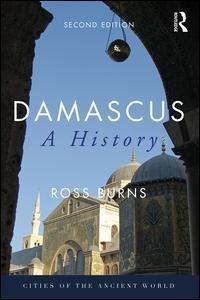Damascus (2nd Ed.) A History Cities of the Ancient World Series
Auteur : Burns Ross

Damascus, first published in 2005, was the first account in English of the history of the city, bringing out the crucial role it has played at many points in the region?s past. It traces the story of this colourful, significant and complex city through its physical development, from the its emergence in around 7000 BC through the changing cavalcade of Aramaean, Persian, Greek, Roman, Byzantine, Arab, Turkish and French rulers to independence in 1946. This new edition has been thoroughly updated using recent scholarship and includes an additional chapter placing the events of the Syrian post-2011 conflict in the context of the city?s tumultuous experiences over the last century.
This volume is a must-read for anyone interested in the sweep of Syrian history and archaeology, and is an ideal partner to Burns? Aleppo (2016). Lavishly illustrated, Damascus: A History remains a unique and compelling exploration of this fascinating city.
List of Illustrations; List of Maps; Foreword; List of Abbreviations; Introduction; PART ONE; Chapter 1 – The Emergence of Damascus (9000 – c1100 BC); Chapter 2 – Dimashqu – Damascus from the Aramaeans to the Assyrians (c1100 – 732 BC); Chapter 3 – A Greater Game – Assyrians, Persians, Greeks (732 – c300 BC); Chapter 4 – The Sowing of Hellenism – Ptolemies and Seleucids (300 – 64 BC); Chapter 5 – Towards a Pax Romana (64 BC – AD 30); Chapter 6 – Metropolis Romana (AD 30 – 268); Chapter 7 – Holding the Line (AD 269 – 610); Chapter 8 – ‘Farewell, Oh Syria’ (611 – 661); Chapter 9 – The Umayyads (661 – 750); PART TWO; Preface to Part Two - When did the ancient end?; Chapter 10 – Decline, Confusion and Irrelevance (750 – 1008); Chapter 11 – Islam Resurgent (1098 – 1174); Chapter 12 – Saladin and the Ayyubids (1174 – 1250); Chapter 13 – Mamluks (1250 – 1515); Chapter 14 – The First Ottoman Centuries (1516 – 1840); Chapter 15 – Reform and Reaction (1840 – 1918); Chapter 16 Epilogue – Countdown to Catastrophe (1919–2011); Glossary of Terms and Names; Maps of City and Environs; Bibliography; Index
Ross Burns was in the Australian Department of Foreign Affairs for 37 years until his retirement in 2003, including as Ambassador to Syria from 1984 to 1987. After his retirement, he completed a PhD at Macquarie University in Sydney on ‘The Origins of the Colonnaded Streets in the Cities of the Roman East’. He is the author of Aleppo (2016) and Monuments of Syria (3rd edition, 2009).
Date de parution : 02-2019
15.6x23.4 cm
Date de parution : 01-2019
15.6x23.4 cm
Thème de Damascus :
Mots-clés :
Young Men; Conrad III; Damascus; Darius III; Syria; Thutmose III; Syrian history; Ramses III; Syrian conflict; Holy Mountain; Syrian archaeology; Khalid Ibn Al Walid; Dimashqu; Uniate Christians; middle eastern archaeology; Al Salih Ayyub; middle eastern history; Scaenae Frons; persian damascus; Umayyad Mosque; Aramaean damascus; Victoria Bridge; hellenistic damascus; Amir Al Hajj; hellenistic syria; Pompey’s Settlement; syrian under the persian empire; Marj Dabiq; assyrian damascus; Bab Sharqi; roman syria; Strata Diocletiana; roman damascus; Dar Al Hadith; Umayyad syria; Ibn Jubayr; Umayyad damascus; City’s Religious Life; Ayyubid syria; Ayyubid damascus; malmuk syria; malmuk damascus; Ottoman syria; ottoman damscus; ash-Sham; city of jasmine; Madīnat al-Yāsmīn; history of the levant; archaeology of the levant; Dammeśeq; Dimašqa; Darmeśeq; Tell Ramad; damascus and the hittites; damascus and ancient egypt; bronze age syria; bronze age damascus; Aram-Damascus; the Decapolis; Old Town of Damascus; Tekkiye Mosque; Sultan Selim Mosque; french mandate in syria



